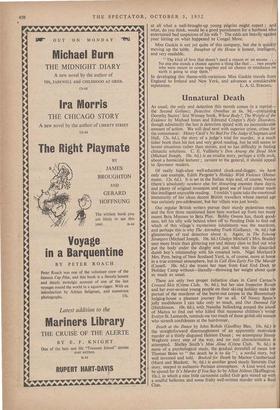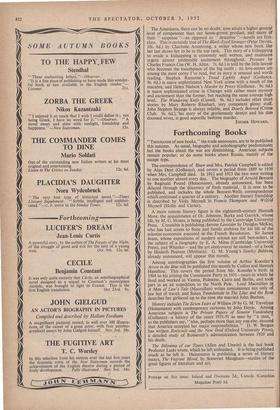Unnatural Death
As usual, the only real detection this month comes in a reprint— the Second Gollancz Detective Omnibus at 6s. 9d.—containing Dorothy Sayers' first Wimsey book, Whose Body?, The Weight of the Evidence by Michael Inns and Edmund Crispin's Holy Disorders, though admittedly the last is detection spiced with no inconsiderable amount of action. We will deal next with superior crime, crime for the connoisseur. Henry Cecil's No Bail For The Judge (Chapman and Hall, 12s. 6d.), the story of a judge's trial for murder, is a much tidier book than his last and very good reading, but he still seems to invent situations rather than stories, and so has difficulty in finding climactic solutions. C. E. Vulliamy's Don Among the Dead Men (Michael Joseph. 10s. 6d.) is an erudite story, perhaps a trifle arch, about a homicidal lecturer ; caviare to the general, it should appeal to Spectator readers.
Of really high-class well-educated cloak-and-dagger, We have only one example, Edith Pargeter's Holiday With Violence (Heine- mann. 12s. 6d.). It is set in the Italian Alps and, of course, Venice (there's absolutely nowhere else for thwarting enemies these days), and plenty of original invention and good use of local colour made this intelligent enjoyable reading. I couldn't quite take the emotional immaturity of her clean decent British travellers whose mental age was certainly pre-adolescent, but her villain was just lovely.
Our regular British writers pursue their sturdy pedestrian ways, and the first three mentioned have here worked up from too many recent Beta Minuses to Beta Plus. Bobby Owens has, thank good- ness, left his silly wife behind when off to Pending Dale to find out which of this village's mysterious inhabitants was the murderer, and perhaps this is why The Attending Truth (Gollancz. 9s. 6d.) Nis glimmerings of real detection about it. Again, in The Echoi l Strangers (Michael Joseph. 10s. 6d.) Gladys Mitchell's Mrs. Bradl uses more brain than glittering eye and skinny claw to find out whp put the body under the dinghy and just what was the discarded dumb boy's relationship with his cosseted twin. Nigel Morland Mrs. Pym, being of New Scotland Yard, is, of course, more at home in a true criminal atmosphere, but in Call Hhn Early For The Murder (Cassell. 10s. 6d.) she traces her man from East End Dock to Holiday Camp without—literally—throwing her weight about quite so much as usual.
There are only two proper inductive clues in Carol Carnac's Crossed Skis (Crime Club. 9s. 6d.), but her nice Inspector Rivers and her ever-so-nice young people on their ski-ing holiday make the pursuit of the murderer of the burnt-out corpse in the Bloomsbury lodging-house a pleasant journey for us all. Of Nancy Spain's jolly modishness I can take only so much, and Out Damned nit (Hutchinson. 10s. 6d.), with Natasha bullocking around the island of Manya to find out who killed that nauseous children's writer Evelyn St. Leonards, reminds me too much of those girlish old women who screech confidences at the hairdresser.
Death at the Dance by John Rohde (Geoffrey Bles. 10s. 6d.) is the straightforward disentanglement of an apparently motiveless murder at a thinly disguised Helston Dance ; we accompany Jimmy Waghorn every step of the way, and no real characterisation is attempted. Shelley Smith's Man Alone (Crime Club. 9s. 6d.) is more of a psychological study, the gradual downfall of mean toiv Thomas Bates to " the death he is to die " ; a sordid story, but well invented and told. Booked for Death by Marten Cumberland (Hurst and Blackett. 9s. 6d.) is another good steady Saturnin Dax story, steeped in authentic Parisian atmosphere. A kind word must be spared for It's Murder If You Say So by Allan Aldous (Skeffington. 10s.), in which a nice little cartoonist called Gub gets mixed up with a soulful ballerina and some fruity well-written murder with a Real Clue. The Americans, there can be no doubt, now attain a higher general level of competence than our home-grown product, and many of their " suspense "—as opposed to " detective "—novels are first- class. This is certainly true of The Black-Eyed Stranger (Peter Davies. 10s. 6d.) by Charlotte Armstrong, a writer whose new book like her last shows her to be in the top rank. This story of a kidnapping to evade a kidnapping is extremely well written, and maintains urgent almost intolerable excitement throughout. Pressure by Charles Francis Coe (W. H. Allen. 7s. 6d.) is told by the little lawyer who becomes the mouthpiece of the big outfit ; its love-scenes are among the most corny I've read, but its story is unusual and worth reading. Stephen Ransome's Tread Lightly Angel (Gollancz. 9s. 6d.) is suave sophisticated New York crime with a touch of the macabre, and Helen Nielson's Murder by Proxy (Gollancz. 9s. 6d.) is suave sophisticated crime in Chicago with rather more mystery and excitement than the former, but reaching the same average high level. The Wandering Knife (Cassell. 9s. 6d.) includes other short stories by Mary Roberts Rinehart, very competent glossy stuff. John Stephen Strange is always reliable, and Dearly Beloved (Crime Club. 9s. 6d.), his story of the gentlemanly dentist and his dim doomed wives, is good soporific bedtime murder.
ESTHER HOWARD.



















































 Previous page
Previous page